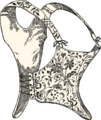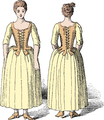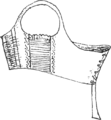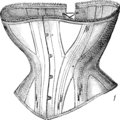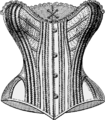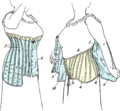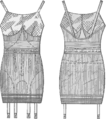History of corsets
Corsets were first widely worn during the 16th century (first attested in Spain in the late 15th century as a upper part of the spread skirts of the incipient farthingale)[1], and generally remained a feature of fashionable dress until the French Revolution (1789). These corsets were mainly designed to turn the torso into the fashionable cylindrical shape, although they narrowed the waist as well. They had shoulder straps; they ended at the waist; they flattened the bust, and in so doing, pushed the breasts up. The emphasis of the corset was less on the smallness of the waist than on the contrast between the rigid flatness of the bodice front and the curving tops of the breasts peeking over the top of the corset.
The corset then went into eclipse. Fashion embraced the Empire silhouette: a Graeco-Roman style, with the scanty skirts gathered under the bosom and the waist de-emphasised, and dresses sewn from thin muslins rather than the heavy brocades and satins of aristocratic high fashion.
The reign of the Empire waist was short. In the 1830s, shoulders widened (with puffy gigot sleeves or flounces), skirts widened (layers of stiffened petticoats), and the waist narrowed and migrated towards its "natural" position. By the 1850s, exaggerated shoulders were out of fashion and waistlines were cinched at the natural waist, above a wide skirt. Fashion had achieved what we now tend to remember as the Victorian silhouette.
Before the mid-19th century, the prevailing term in English was "pair of stays; ladies stays; girls stays" (but "corset in French).
In the 1830s, the artificially inflated shoulders and skirts made the intervening waist look narrow, even with the corset laced only moderately. When the exaggerated shoulders disappeared, the waist itself had to be cinched tightly in order to achieve the same effect. It is in the 1840s and 1850s that tightlacing is first recorded. It was ordinary fashion taken to an extreme. The Victorian and Edwardian corset differed from earlier corsets in numerous ways. The corset no longer ended at the waist, but flared out and ended several inches below the waist. The corset was exaggeratedly curvaceous rather than cylindrical.
15th century
[edit]
NOTE: This image does not actually depict a "corset" in the usual modern sense of the word (a woman's undergarment intended to constrict and/or support the torso), but "corset" in the original medieval French and German sense of the word.
It is common as women's clothes take the name from men's clothes.
16th century
[edit]-
16th century
-
16th century
18th century
[edit]-
18th century
-
18th century
-
18th century of cheap leather
1808-1830
[edit]-
A good illustration of one form of Empire/Regency short stays
-
cropped version
-
1803 short stays
-
1808 short stays
-
1808 short stays
-
1808 (anatomically somewhat strange illustration)
-
1810 "long stays"
-
1822 boneless front-lacing short stays
1808-1851
[edit]
from the weight of the dress on the shoulders.
-
1830
-
1830
-
1835. Note! Sloping shoulders.
-
1850. Girl's corset.
1851 — Madame Roxey Ann Caplin.
[edit]At the Great Exhibition in 1851 Madame Roxey Ann Caplin was awarded the prize medal of "Manufacturer, Designer and Inventor" for her corsetry designs, as the only corsetmaker who get a prize by the Great Exhibition. This prize medal changed the corsetry of England.
-
A lady's corset.
-
Gestation corset (pregnancy).
-
Child's bodice. (Back)
-
Petticoat Suspender (a predecessor to the crinoline).
1851-1874
[edit]The shoulder straps disappear from some adult ladies's corsets.
-
1859
-
1860
-
1862
-
1863
-
1864
-
1865
-
1866 whalebone grating
-
1867
-
1868
-
1869
-
1870 whalebone grating
-
1870
-
1871
-
1872
-
1874
Natural Form and Cuirass Body 1875-1882
[edit]-
1875
-
1876
-
1877
-
1878
-
1878
-
1878
-
ca. 1880
-
1880 Girl's corset
-
1881
-
Lady's corset, front
-
Lady's corset, back
Return of the Bustle 1883-1890
[edit]-
1883
-
1884
-
1886
-
1887
-
1887
-
1889
-
1889
-
1890
Hourglass Figure 1891-1899
[edit]-
1892
-
1892
-
1893
-
1894
-
1896
-
1897
-
1898
-
1898
-
1899
1900-1909 (Edwardian)
[edit]This era had three types of corsets
1900-1905
[edit]Curved back.
-
The first corset of this type, but 21 years too early.
-
1900 illustration contrasting the old Victorian corseted silhouette with the new Edwardian "S-bend" corseted silhouette.
-
1900
-
1901
-
1903
-
1904
-
1904
-
1905
-
c. 1904
1906-1908
[edit]
Thin waistline, full hip, medium curved back
-
1906
-
1907
-
1908
1908-c. 1914 Post-Edwardian long line
[edit]
The tight waist end in 1908. 'From 1908 to 1913 the style of dresses became slimmer through the lower waist and hips, so corsets grew longer. A new type of fashionable corset covered the thighs and changed the position of the hip, making the waist become both higher and wider. The new fashion was considered uncomfortable, cumbersome, and furthermore required the use of strips of elastic fabric.
The corset is long and have a small high curved back.
-
1909 false bosom.
-
1909
-
1910
-
1910
-
1910
-
1911 the last tight waist
-
1912
-
1912
-
the change from 1910s to 1920s or the change from 1912 to 1914s
1913-1914 The longest long line corset
[edit]
Corset by legs. Many older corset was continuous in use, but the new corset in this year was extreme long.
-
1913
-
1913
-
1913 opening for motion
-
1913
-
The change in corset 1913-1914. The abdomen and loin curve revived, for a time.
1914-1920
[edit]Corset, shorter shorter and loose. A suggestion of belly. The long corset be at the hip, not at the waist as before. Because the hip move in position to the chest, this corset have need of a brassiere.
-
1914
-
1914
-
1915
-
1916
-
1916 opening for motion
-
1916
-
1917
-
1917
-
1917
-
1918
-
The change in shape about 1919.
-
1919
-
1920
-
1920
-
1920
Corselettes 1918-1960
[edit]The corselette was often something like a single garment combining the functions of brassiere and girdle (in the 1920's, it was often worn with the object of achieving a boyish figure). The corset in that era was as long girdle by spiral springs.
-
1922
-
1922 Corset
-
1923 Corset
-
1924 Corset
-
1925
-
1927
-
1928 Corset
-
1932
-
1930 Corset
-
1930 Corset
-
1933
-
1935
-
1941
-
1942
-
1948
-
1959
1960- 1980
[edit]Panty hose has largely displaced girdles and corselettes from common use.
-
1962
-
1963
-
1965
-
1975
1980-today
[edit]The corset get a rebirth as visible dress.
See also
[edit]- ↑ Corsets and Criolines; Norah Waugh; Frontispiece


